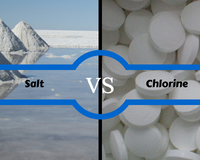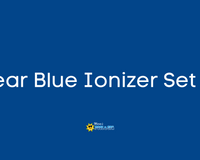Problems with your hot tub water?
Below are the most common water issues found in spas in our area and how to treat them. if you have any questions, please reach out to us anytime.Cloudy / Green Water
Sanitizer is key. Make sure that the free chlorine / bromine is always present in the water and showing on your test strips (1-3ppm) If water is clear/tinted green see section 4 ‘Staining’
In the event of the water going cloudy, milky or even green. Don’t panic. All that means is that the sanitizer levels have becomes low enough to where the bacteria can thrive and grow.
First check your free sanitizer levels on a test strip. (Free Chlorine / Bromine) If low, you can add one chlorine / bromine puck into the floating dispenser (One at a time, replenishing when dissolved) Additionally, add one tsp of granulated chlorine / bromine sanitizer directly into the water. This will kill anything growing or trying to grow in the water. The last step is to repeatedly rinse out or completely change the filter. (If needed)
If the spa remains cloudy after 24+ hours, monitor the sanitizer level and replenish as needed. (1 tsp at a time) Ensure you maintain a slightly higher than normal level of sanitizer throughout this process. Continue to rinse your filter every 24 hours until the spa is clear.
Maintain higher sanitizer levels throughout the whole process, bringing levels back down to normal once clear (1-3 ppm)
Note: Chlorine and bromine cannot be mixed or used together.
Bubbles / Foamy Water
There are two possible reasons as to why you’re experiencing bubbles / foaming in your water.
If the foaming is minimal and when the jets stop running the foam settles down rather quickly, that’s more consistent with an imbalance of the water.
The first and most common reason is simply due to an imbalance with our alkalinity and calcium levels. (Confirm this with a test strip) If ever one or both is off, whether they’re too high or too low there is a chance of having foam occur. We can fix this by adding either alkalinity or calcium, and correcting the balancing of the water. You will notice a difference within the first 24hrs.
If the foaming is consistently rising and/or does not settle back down relatively quickly (Within 1-3 minutes) there is a good chance of having phosphates present in the water.
The second reason as to why there may be foam in the water is due to phosphates. Phosphates are an accumulation of detergents, shampoo’s, lotions, deodorants etc... Once built up in the water, phosphates are near impossible to completely remove. There are chemicals you can add to help lower phosphate levels, however they’re not a guaranteed solution and can create a build up inside of plumbing after continued use. Depending on the levels of the phosphates, you will more than likely have to drain and refill with new water.
To reduce phosphate buildup, be sure not to enter the tub with heavy amounts of lotion, residual shampoo or fabric softeners or detergents in your bathing suit(s). Hang to dry.
Phosphates are safe to swim in, but will deplete your sanitizer levels extremely fast, potentially causing clarity issues with the water.
Mineral Staining / Tinted Water
Only applies if your water comes from a well, or the town of Oromocto. Mineral staining is common to occur when the proper preventatives are not put in place. Without any preventatives the sanitizer and minerals from the well will create chemical reaction, effecting the water. You may experience discoloured, tinted but clear water, or even a slight staining around the tub and/or pool. Depending on whichever mineral is most prevalent in the water, it can turn green, brown and/or even black.
You do not have to drain the water, mineral staining is treatable. This is not harmful to your body, rather an annoyance to deal with and have present in the water.
Preventatives such as Dazzle Stain & Scale, Spa Metal Free or the Mineraluxe Cubes are highly recommended to prevent any discolouration and/or staining regarding the spa water and equipment. These preventatives should be done on a weekly basis. Preventatives must be in place and in the water for a minimum of 12 hrs prior to adding any sanitizer.
If the water has already changed color or you’re noticing any staining we recommend a product called Stain Free. This product will reverse any discoloration and staining that is occurring within the first 24hrs to 48hrs Follow this process with your regular routine Stain & Scale preventive treatment once the water is clear.
NOTE: There is the possibility of having mineral staining and algae present in the water at the same time. Algae will be slimy, cloudy and hard to see through. To determine if both are present, we will treat the water as if it is algae first, as mineral staining is safe to swim in. After doing so you should notice the water get clear but still tinted green, that’s when we will treat it for mineral staining.
Water Balancing
Water balancing is very important to keep up to date and correct. It increases the longevity of the tub itself and all of its components attached, all while keeping the water clear and safe for use.
You can balance your water at home by making adjustments based on the readings you get from the test strip.
The most common balancing chemicals you’re expected to use are -
Calcium Plus: If your hardness levels are too low you can use calcium plus to increase the levels of the water.
Alkalinity Plus: If your alkalinity levels are too low you can use alkalinity plus to increase the levels of the water.
PH Minus: If your PH levels are too high you can use PH minus to lower the levels of the water. (Will lower both alkalinity and PH levels)
PH Plus: If your PH levels are too low you can use PH plus to raise the levels of the water. (Only add if alkalinity is balanced and PH is still low)
Don’t stress too much over the PH levels. It is common for the PH to fluctuate everyday and hover around 7-7.8 on the test strips. The alkalinity will control your PH and keep it in the proper range. If your PH levels are off and incorrect, first test to see if the alkalinity is balanced and where it needs to be.
Only correct the alkalinity if both are imbalanced.
Examples:
Alkalinity is over 120 and/or PH is too high: Add PH minus to lower both
Alkalinity is under 120 and PH is low: Add alkalinity plus
Alkalinity is 120 but the PH is low: Add PH plus
Alkalinity is 120 but the PH is too high: Add alkalinity plus (Wait 4hrs) then add PH minus
Calcium is too high: Dilute with fresh water (This will dilute any of the other chemicals during the process)
Calcium is too low: Add Calcium (Hardness) plus
Sanitizer is too low: Add 1 tsp of granulated chlorine / bromine
Sanitizer is too high: Remove puck inside floating dispenser












